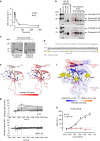Oxidation of the alarmin IL-33 regulates ST2-dependent inflammation
- PMID: 26365875
- PMCID: PMC4579851
- DOI: 10.1038/ncomms9327
Oxidation of the alarmin IL-33 regulates ST2-dependent inflammation
Abstract
In response to infections and irritants, the respiratory epithelium releases the alarmin interleukin (IL)-33 to elicit a rapid immune response. However, little is known about the regulation of IL-33 following its release. Here we report that the biological activity of IL-33 at its receptor ST2 is rapidly terminated in the extracellular environment by the formation of two disulphide bridges, resulting in an extensive conformational change that disrupts the ST2 binding site. Both reduced (active) and disulphide bonded (inactive) forms of IL-33 can be detected in lung lavage samples from mice challenged with Alternaria extract and in sputum from patients with moderate-severe asthma. We propose that this mechanism for the rapid inactivation of secreted IL-33 constitutes a 'molecular clock' that limits the range and duration of ST2-dependent immunological responses to airway stimuli. Other IL-1 family members are also susceptible to cysteine oxidation changes that could regulate their activity and systemic exposure through a similar mechanism.
Conflict of interest statement
C.E.B. has received research support and consultancy fees from GSK, MedImmune, BI, Novartis, Roche, and Chiesi and has received travel support from BI, the European Respiratory Society, and the American Thoracic Society. The remaining authors are employees of the AstraZeneca Group and have stock/stock options in AstraZeneca.
Figures




References
-
- Schmitz J. et al.. IL-33, an interleukin-1-like cytokine that signals via the IL-1 receptor-related protein ST2 and induces T helper type 2-associated cytokines. Immunity 23, 479–490 (2005). - PubMed
-
- Pichery M. et al.. Endogenous IL-33 is highly expressed in mouse epithelial barrier tissues, lymphoid organs, brain, embryos, and inflamed tissues: in situ analysis using a novel Il-33-LacZ gene trap reporter strain. J. Immunol. 188, 3488–3495 (2012). - PubMed
Publication types
MeSH terms
Substances
LinkOut - more resources
Full Text Sources
Other Literature Sources
Medical
Molecular Biology Databases

